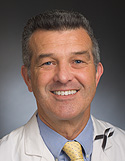The drug Avastin, when added to initial therapy for glioblastoma, can give patients a few extra months’ reprieve before their brain tumors start growing again, but does it make their quality of life better – or worse?
That’s a matter of heated debate for doctors – and confusion for patients – after two large clinical trials reported conflicting results at the annual American Society of Clinical Oncology (ASCO) conference in June. Some experts contend that Avastin lacked sufficient benefit for use as an “upfront” treatment for glioblastomas – the most common and aggressive brain tumors.
But others disagree – including specialists in Dana-Farber’s Center for Neuro-Oncology.

“We feel very strongly that Avastin is a major advance and has significant benefit both in controlling the disease and improving function and quality of life,” say David Reardon, MD, clinical director, and Patrick Wen, MD, director.
“We need to critically review the data from both studies before any conclusions are drawn,” Reardon says. “But we continue to feel that this is a good drug – it’s not a home run, but it helps the majority of our patients feel better and delays the progression of their disease.”
Avastin (bevacizumab) is an anti-angiogenesis compound: It blocks a protein that helps tumors gain nourishment by growing new blood vessels. The Food and Drug Administration (FDA) has approved its use only in patients experiencing a recurrence of glioblastoma.
The two clinical trials – called AVAglia and RTOG 0825 – asked a different question: Does Avastin have significant benefit for the initial treatment of glioblastoma patients following surgery when added to the standard regimen of radiation and the drug Temodar (temozolomide)?

The studies agreed on the main points: adding Avastin to standard therapies didn’t extend overall survival, but controlled the tumors’ growth for three or four months longer before they progressed, on average, than patients who received a placebo.
The disagreement came when the AVAglia study found that patients receiving Avastin generally felt better and were more physically and socially active, scoring higher on a number of quality-of-life measures, than those who got a placebo. The RTOG 0825 trial, however, reported more adverse effects, poorer quality of life, and a significant decline in cognitive functions like memory, planning, organization, and processing speed.
At the urging of glioblastoma patient groups, the FDA has agreed to an in-depth review of the data to resolve the discrepancies. The trials didn’t use exactly the same methods to measure quality of life, notes Reardon, and many of the subjects in RTOG 0825 didn’t participate in that aspect of the trial. Another question is whether the cognitive declines seen in that study might have been caused by undiagnosed progression of the tumors.
“We feel the AVAglia data are a bit more solid, and reflect what we see in our clinic,” Reardon says. “That is, that most patients, once they take Avastin, are feeling better – they can reduce their doses of steroid drugs, and are better able to care for themselves and participate in family and work.”

On 7/17/2013 i will have survived having Glioblastoma for 3 years.I have been taking Avastin twice a month for nearly all of those 3 years. I have done really well with Avastin and my recent MRI scans that i have every two months continue to show no cancer. If my upcoming PET scan and MRI on 8/13/2013 look good, stopping Avastin will be considered. I feel that Avastin has worked for me.My next test is to see where i am at in a few months after i have stopped taking Avastin.
My dad (55) was diagnosed with GBM on 01/03/2013. He was placed on radiotherapy and Temodar for 45 days. After that, he continued with maintenance chemo with Temodar. On 09/15/2014 his tumor started to grow, Temodar was no longer working. On 10/20/2014 placed on Avastin. Today, 11/12/2014 we were showed his MRI images and there was a significant difference from the images when he was on Temodar. We are scared of Avastin side effects, but we really hope they are minimal compared to the benefits. We also made changes on his diet (mainly NO SUGARS) , I strongly believe this helped too.
September 1995 my father had his grand-mall seizure that month he had open brain surgery he has had radiation twice and chemo now 3 times. his last time was avastian for a year yes it has stopped his tumor from progressing but though the years the gliobastoma brain tumor has taken so much from him. we are stopping his treatment as of today. but my father is a survivor since 1995 now almost 20 years.
Dear Amy —
We are so sorry about your father’s health trouble, but it is wonderful to hear that you have been able to spend many years with him. Sending our thoughts to you and your family.
Approximately how much is the Avastin per treatment? We were told it could cost of $100,000 a year. We don’t have prescription coverage on our Blue Cross policy.
Thanks.
Dear Barbie —
Thank you for your comment and for reading Insight. It is best for you to bring up any treatment cost questions with your provider, who will be able to give you more information. If you are looking for more information about finances/payment at Dana-Farber, check out this page on our website.
I hope this is helpful. Wishing you all the best.